Veteran’s Testimony – Patsy Passero Medical Detachment, 3d Battalion, 505th Parachute Infantry Regiment, 82d Airborne Division
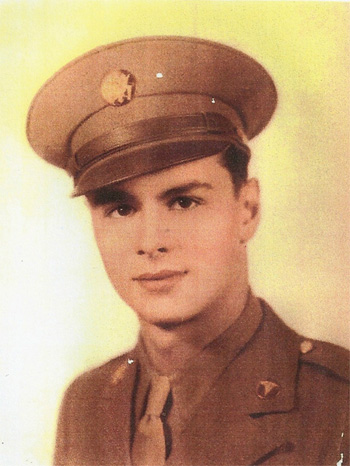
Studio picture of Private Patsy Passero, ASN 32580085, when he was still serving with the US Army Air Corps in Florida. Photo taken in December 1942 and forwarded to his folks for Christmas.
Introduction:
My name is Pasquale “Patsy” Passero. I hailed from Niagara Falls County, New York where I was born 15 March 1924. My parents were Armando and Antonetta Passero, Italian immigrants. The Passeros were a real Military Family; they even have a crest bestowed by the Vatican for their support during the Crusades. Being real patriots, they served Uncle Sam well! Ten children were born to Armando & Antonetta: Patsy (82d Airborne, ETO); Louise; Yolanda (US Navy, Zone of Interior); Roland (served on a US Navy submarine, South Pacific Area): Angela; Theodore (15th US Army Air Force, Southwest Pacific Area); Gloria; Lucille; Mario (7th US Army, Germany); and Albert. In addition, nephew Henry served multiple tours in Vietnam with the 5th US Marine Regiment; and nephew Chad served with the 101st Airborne, in Iraq.
After 6 years of Grammar School, I spent 4 years at Trott Vocational High School, Niagara Falls, New York, where I majored in bookkeeping – typing – and other commercial subjects, I was inducted by the Army of the United States under the Selective Service Act. After leaving High School, I did some odd jobs, I was then 18 years old. I entered into active service at Buffalo, New York, 2 November 1942 (Selective Service Board # 583), electing to join the Army Air Forces where I became a Basic Airman (ASN 32580085) in the Medical Department (the USAAF needed more aidmen and medical personnel -ed).
In November 1942 I was stationed at Army Air Base No. 6, St. Petersburg, Florida, where I was assigned to the 586th Training School Squadron (T.S.S. units were under control of the Army Air Forces Training Command –ed). After completing basic training I joined the 50th Fighter Control Squadron.
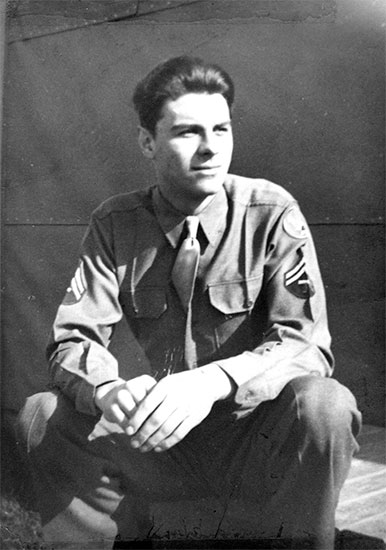
Technician 5th Grade Patsy Passero, while serving with the Army Air Forces.
Training & Movement Overseas:
I took Basic Training during 1 ½ months (MOS 521, AAF), then received more to become a Medical Aidman (MOS 657, USA). During my assignment I continued medical training and was sent to a Technicians School in Atlanta, Georgia, for three months to improve my skills and medical technique. I graduated as a Medical Technician (MOS 409, USA) which allowed me to assist Medical Officers in administering and caring for the sick and wounded and to provide first aid to the wounded in combat. At the end of the period I returned to my outfit in Florida.
We only remained 4 months in Florida and were soon alerted to prepare for movement overseas. My outfit, together with a large contingent of United States Army Air Force personnel were expected to be transferred to the United Kingdom some time during April / May of 1943. I traveled aboard RMS “Queen Elizabeth”, sailing on 27 May 1943 and arriving at Greenock, Scotland, on 2 June 1943. The ship’s most precious cargo were ground personnel pertaining to the 384th Bombardment Group (assigned to 41st Bombardment Wing, 1st Bombardment Division, 8th US Army Air Force –ed), who after moving to Sioux City Army Air Base, Iowa, for final training, subsequently left for Camp Kilmer, Stelton, New Jersey, on 9 May 1943, with orders to prepare for movement overseas (the Group’s aircraft left Sioux City for Kearney, Nebraska, on 3 May 1943, and then proceeded to the United Kingdom, via Bangor, Goose Bay, and Gander, with the first aircraft reaching England 25 May 1943 –ed). We ended up being stationed at Hinxton, near Duxford (AAF-357), in Cambridgeshire, England, as part of the 8th US Air Force Fighter Command.

Personnel from USAAF Fighter Control Squadrons aboard a lighter heading for shore, Gourock, Scotland. The troops were part of a large contingent of USAAF men to arrive in the United Kingdom on 11 May 1943. Patsy was part of another Army Air Forces contingent that was sent overseas end of May 1943.
New Assignment:
The 82d Airborne Division was looking for replacements after its previous operations in the Mediterranean Theater, and I appeared to read one of the recruiting bulletins posted on one of the rumor boards. Coming from the Army Air Forces (8th USAAF) and stationed in the United Kingdom, I was looking for more ‘action’ since my own job was rather boring. The Airborne were still looking for volunteers and replacements and as I was interested, I asked my Commanding Officer if he would let me go in order to join the Paratroops. After convincing my Officer, the latter accepted, and, together with a friend, I signed up for the Airborne. I was transferred to my new outfit in July 1944, too late to see action in France, and moved to Camp Quorn, where I was eventually assigned to the Medical Detachment, 3d Battalion, 505th Parachute Infantry Regiment. My job was that of a Medical Aidman (MOS 409, USA) in I Company.

Picture illustrating some Officers of I Company, 505th Parachute Infantry Regiment, 82d Airborne Division. Picture taken at Camp Quorn, England, spring of 1944. Standing, from L to R: unknown, 1st Lieutenant Walter B. Kroener, Captain Harold H. Swingler (KIA 6 Jun 44), 1st Lieutenant Joseph W. Vandervegt. Kneeling, from L to R: 1st Lieutenant Shelby O. Irwin (D Co), 2d Lieutenant Robert F. Howell, 1st Lieutenant William J. Brunsman, 1st Lieutenant George E. Clark, Jr.
I was trained for the Airborne Infantry, and getting prepared to reach jump status and obtain the coveted “Jump Wings”. While in England, I completed the prescribed course in “Parachute Packing, Ground Training, and Jumping from a Plane in Flight”, qualifying as a parachutist on 22 October 1944.
France:
After the Holland campaign, the “All American” Division eventually moved to France. The day preceding Thanksgiving, the 505th rolled through the gates of the old French Artillery Camp that had been re-christened “Camp Suippes” (in fact an extension to Camp Mourmelon, established after WW1 –ed). It was situated east of Reims, a large city saturated with SHAEF Headquarters and related troops. We often got passes to visit Châlons-en-Champagne, approximately 20 miles south of Suippes, where the inevitable brawls and fights took place between 82d and 101st Airborne personnel (the latter came from Mourmelon-le-Grand –ed). Casualties had been heavy during the Holland campaign, and with the lightly wounded gradually returning and the arrival of new replacements, our Regiment was slowly building up its authorized T/O strength. I had been assigned to Item Company, 3d Battalion shortly before January 1945.
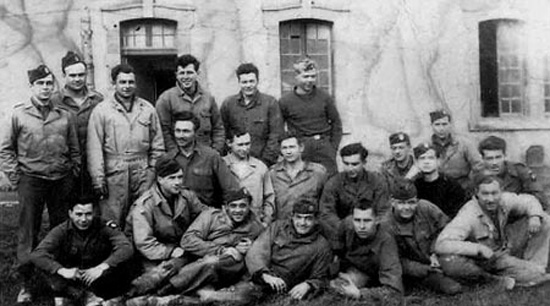
Personnel of the 505th Parachute Infantry Regiment, at Camp Suippes, France. The former French Barracks became the next station for the “All Americans” after Camp Quorn was shut down and was intended for what appeared to be the men’s new winter’s stay …
Camp Suippes would serve as barracks and training grounds until the Regiment would be needed again. The setup consisted of a number of two-story buildings, some big halls, a theater, some recreation facilities, and a large courtyard. Time was spent with hard training, close order drill, hikes, range firing, and lectures. Having been spoiled by the cooks serving the traditional turkey with trimmings on Thanksgiving Day, everyone in the 505th was looking forward for more of the same on Christmas.
On the night of 17 December 1944, after attending some movies, we returned to the barracks and went to bed. About 0200 hours in the morning, one of the Platoon Sergeants banged on the door of some NCOs, and told them to get every man ready to move out with full equipment by 0900! It was reported that the Germans had busted through the Belgian Ardennes and we had to stop them (both the 82d and 101st Airborne were the only SHAEF reserve on the continent at the time –ed).
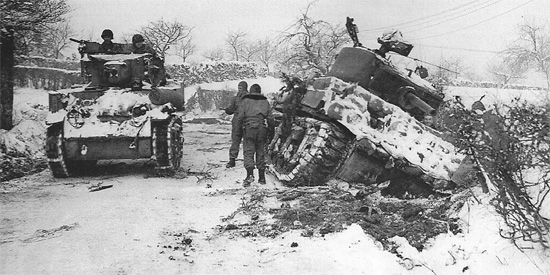
Battle of the Bulge. American armor trying to negotiate difficult terrain in severe winter conditions.
I recall that I sustained my first combat wound in action during the attack against Fosse, on 3 January 1945 … a bad start …
Battle of the Bulge:
Sensing that the Battle of the Bulge crisis was over, Allied Commanders decided to mount a counterattack in order to cut the German salient and regain the initiative. The following forces were allotted to XVIII Airborne Corps: 30th Infantry Division – 82d Airborne Division – 7th Armored Division, plus a number of previously-assigned units such as CCB / 9th Armored Division – remnants of the 106th Infantry Division – 112th Infantry Regiment / 28th Infantry Division – and elements of the 509th Parachute Infantry Battalion. The main weight of the offensive would be carried by Gavin’s “All American”, including the 517th Parachute Infantry Regiment, the 460th Parachute Field Artillery Battalion (75mm howizers), and the 551st Parachute Infantry Battalion. After having been pulled back and ordered into reserve, this must have been 1 January 1945, our unit as well as the other Regiments or Battalions were still not at full strength! Our Company pulled into a large snowy grove of pines and settled down for the night. Fires were allowed since we must have been about a good four miles behind the lines, and it was wonderful to sit around a fire with the other guys and drink something warm. In the morning of 2 January, some of the men practiced rifle grenade firing at trees. What really made our day was when we received our first mail in many weeks. It was always comforting to read something from home. The lesser news was that we were to attack at dawn the next day.
We learned that our mission was to move to one of the CPs outside of Basse-Bodeux first, assemble for the attack, and head toward the Salm River through a little town called Fosse, somewhere higher in the hills. Our Regimental Surgeon, Major Daniel B. McIlvoy tried to improve evacuation of potential casualties by securing a small number of Weasel M-29 tracked vehicles. He ordered a reconnaissance of the forward areas before the attack in order to establish an Aid Station in a suitable location, and found one just behind the line of departure for the attack, and near to the only bridge across the Salm River. It was an abandoned house previously occupied by Americans, and later taken over by the Germans, and burned down upon their departure.
The attack jumped off on 3 January 1945 in bitter cold and foggy weather, grounding any immediate air support. In order to keep up with the Allied counteroffensive, no unit was expected to be further ahead than another, which meant that some had to reign in their advance. Furthermore, the weather, the icy roads, the enemy roadblocks, the traffic jams, gave the enemy time to dig in on favorable terrain and occupy key high ground!
The immediate objectives for the 505th Prcht Inf Regt were the high ground including the villages of Noirfontaine (2d Battalion), Reharmont (1st Battalion), and Fosse (3d Battalion). The terrain was not only hilly but lavishly covered with wooded areas, providing the enemy with excellent cover and camouflage. My outfit, the 3d Battalion, was ordered to capture Fosse. Another of I Company’s medics, Private First Class John R. Lyons, ASN 42065047, was expecting an easy day as he had been told that there would not be a lot of resistance at Fosse. As more snow was expected to fall, there was no air support. To facilitate movement, we were instructed to leave musette bags, overcoats, and unnecessary equipment behind, hoping that supply sergeants would be able to retrieve them before dark set in. While beginning the climb uphill to Fosse through deep snow, the men were constantly under enemy fire, and after having reached the crest of the hill, they got stopped by intense fire from both the left and the right flanks. Caught in an open area 100 to 200 yards in front of Fosse village, the volume of fire increased to such an extent that it was impossible for the infantry to advance any further. Being thus unable to move, there was no way for some of the men but to move back down the hill and try advancing elsewhere. Reaching the top of the hill once more, more men were hit by enemy MG fire.
As a medic in combat, there is a terrible tension always. You eat, sleep, drink, and fight with these men. You hear about their conquests and defeats, their loves and hates. As a rifleman or machine gunner, when you see one fall, you feel the pain, but you look away. When you are their medic, you die a little each time with them. (John R. Lyons, Private First Class, Medical Detachment, I Company, 505th Parachute Infantry Regiment, Battle of the Bulge, December 1944).
H Company which was to give direct support to my outfit, tried to beat down the incoming fire but were themselves pounded by enemy artillery suffering casualties. When it was obvious that no company could advance any further, the troops were pulled back while Headquarters radioed for armor and artillery support. As I Company retreated for shelter in some neighboring woods, artillery fire hit them and treebursts caused many casualties. Since the area was impassible for tanks, there was no way for our men but to wait until 1st Battalion cleared Reharmont and opened the road to Fosse.
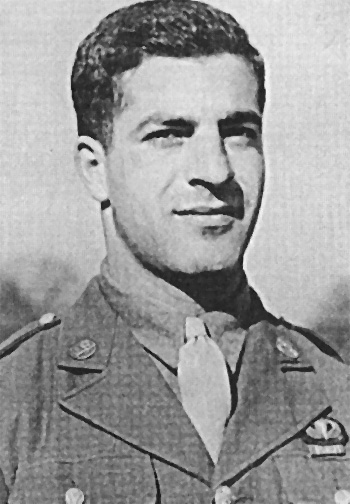
Picture of Pfc Nick A. Cavallaro, 15114204, I Company, 505th PIR, the man Patsy Passero tried to save (KIA 3 January 1945 at Fosse).
We got pinned down by enemy fire, our guys were yelling, and suddenly I hear someone hollering “Medic, Medic”, I slipped thru a fence and some bushes, and ran across this open field, figuring my Geneva Convention brassard would amply protect me. I cut right across the field, crouching down, trying to keep both medical pouches from slapping against my legs, I could see the bullets hitting all around, but I didn’t get hit while I was running and reached the top of the field. There were four of our guys lying there. They looked up at me when I reached them, trying to assess the situation. One trooper had a big wound in his neck – nothing but blood – I could see he was the worst hit of all, because he wasn’t looking at me. The others were talking, yelling, saying things I couldn’t comprehend as I was trying to concentrate on what to do first. I yanked both pouches off over my head and I knelt down alongside the man I figured needed the most attention – Private First Class Nick A. Cavallaro, ASN 15114204. As I knelt to work on Cavallaro, I suddenly felt my legs go from underneath me, it felt like something hot plowing right into me and knocking me flat on my face. I tried to rise, but got hit in the back now, so I just lay there. The other three guys somehow got away, and I was now lying in this snow-covered field, the guy next to me dead. Meanwhile, another medic, Private Dennis R. Force, ASN 39213445, had also reached Nick Cavallaro to help, and he got hit in the face and shoulder. Since I couldn’t stand up, I started crawling backwards, helping myself along with hands and elbows, I kept pushing and pushing, dragging my useless left leg so it wouldn’t get caught, I thought I could get away, but the lead would keep slamming into me. I caught another bullet in my elbow and got hit in the heel too, a terrible experience. I kept thinking about the Germans lacking all respect for medics and the Geneva Convention, because they just kept firing at me! So, I played dead, for some long, very long minutes, God knows how long! I then started to try and move a little, but got fired at again, it looked like the enemy was using me for target practice – a real sitting duck I was… in the end I managed to reach the hedgerow, where I’d started from, and my buddy Private Rocco “Rocky” A. Rubino, ASN 32214197, also a medic, grabbed me by the leg, I almost fainted and let out a yell as it hurt like hell; he then pulled me back thru the fence and behind the hedgerow (Nick Cavallaro died after being hit by enemy machine gun fire, and Patsy Passero was shot in the left knee, the elbow, and in the heel, trying to help him –ed).
Throughout the day many men went thirsty as water in canteens froze solid and natural sources were either non-existent or also frozen. Moreover, there was no time to build a small fire and melt enough snow. The plight of the troopers was bad enough, that of the wounded in many cases tragic. Despite the heroic efforts of the medical personnel, many became casualties themselves, some of the more seriously wounded died of exposure; they either couldn’t move or couldn’t be reached. The most fortunate were the walking wounded, as far as they were able to make it back to the Aid Stations on their own.
Fosse was heavily fortified, the enemy had dug in well, and going uphill was murder, for there wasn’t much cover … I was evacuated by jeep to Basse-Bodeux … Item Company lost thirteen men at Fosse, including a number of medical personnel wounded in action – Private Charles L. Danner, Jr., ASN 33802641; Private Rocco A. Rubino, ASN 32214197; Technician 5th Grade Frank C. Lescinski, ASN 35113854; and Private Thomas F. Greeley, ASN 31297824. More medics would get wounded the following days, with some of them dying of their wounds… the remnants of I Company were then moved into reserve (the 505th PIR suffered over 200 casualties on 3 January 1945 –ed).
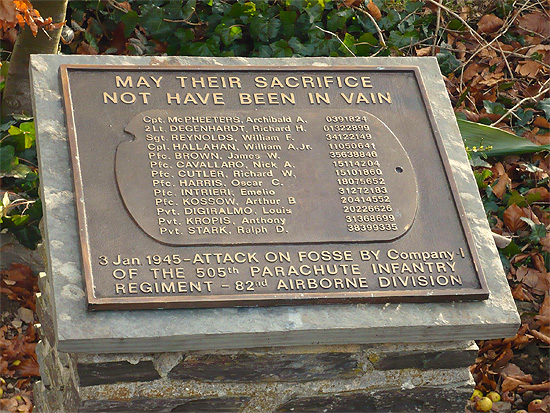
Illustration showing the plaque honoring the memory of the men of I Company who were killed during the attack against Fosse, 3 January 1945.
The 9 January 1945 Company Morning Report, Medical Detachment, 505th Parachute Infantry Regiment, stationed at Camp Suippes, France, signed by 1st Lt. James F. Huffman (Asst. Personnel Officer) states that Pvt Patsy Passero, ASN 32580085, was released from duty after being wounded in Belgium 3 January 1945. After being evacuated to a place unknown, he was released of assignment to Company (i.e. I Co) and attached unassigned.
Personal Awards:
Private First Class Patsy Passero was awarded the Medical Badge for his action in Belgium with GO # 29, 505th Parachute Infantry, APO 469, US Army, dated 8 June 1945.
Technician 5th Grade Patsy Passero was awarded the Army Good Conduct Medal, the American Theater Ribbon, the European African Middle Eastern Theater Ribbon, the Purple Heart Medal, and the WWII Victory Ribbon for his service during World War Two.
Technician 5th Grade Patsy Passero was entitled to the following battle and campaign credits; Ardennes-Alsace and Central Europe, including, Air Offensive Europe, with GO # 33, War Department, dated 1945.
Return to Zone of Interior & Discharge:
As a result of his multiple wounds, Technician 5th Grade Patsy Passero, received a Certificate of Disability for Discharge, ref. Section I, Army Regulations 615-361, issued 4 November 1944. He was listed for evacuation to the Zone of Interior for further treatment and departed the European Theater on 15 April 1945, arriving in the ZI 28 April 1945. Following debarkation, Patsy was sent to Tilton General Hospital, Fort Dix, Wrightstown, New Jersey (initially designated General Hospital by Letter Adjutant General 322.3, dated 9 January 1941; and reconfirmed by War Department General Order No. 64, dated 24 November 1942; wood cantonment, opened for patients 14 July 1941, 3,700-bed capacity; specialties general medicine, general and orthopedic surgery, and psychiatry; redesignated Station Hospital 30 June 1949 –ed), where he was eventually to be discharged. Following a first endorsement of his condition and eligibility for discharge by Tilton General Hospital dated 3 November 1945, and subsequently reconfirmed, Technician 5th Grade Patsy Passero, ASN 32580085, was officially discharged from the service on 15 November 1945.
Finale:
As a young adult with a strong sense of duty, Patsy served in the US Army as a medic with the 82d Airborne Division during the Battle of the Bulge. Although wounded by enemy machinegun fire, his keen sense of responsibility caused him to rush to the aid of a fellow soldier. He was seriously wounded and spent much time recovering in Army Hospitals. A bullet remained in an inoperable position near his spine which caused him to struggle with finding a postwar career. His determination lead him to enter Photography School and he became a self-employed business owner of the “Peter Pan Studio”.
Patsy Passero, sadly passed away on 31 January 2015.

The MRC staff are truly thankful to Technician 5th Grade Patsy Passero (ASN:32580085) for sharing his personal recollections with them. Except for a few editing remarks and some extra illustrations, all texts in this testimony are courtesy of Medic P. Passero, who, in the latter part of WWII served with one of the Medical Detachments of the 505th Parachute Infantry Regiment of the “All American” Division during the Battle of the Bulge. Thanks must also go to his proud Brother, Mario Passero, who served with the Seventh US Army Headquarters Company, Chief Engineering Section, Germany, from 1956 to 1959, for sharing additional data with them.
